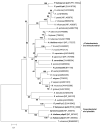A glycine-cleavage complex as part of the folate one-carbon metabolism of Plasmodium falciparum
- PMID: 16039160
- PMCID: PMC2719866
- DOI: 10.1016/j.pt.2005.07.001
A glycine-cleavage complex as part of the folate one-carbon metabolism of Plasmodium falciparum
Abstract
The glycine-cleavage complex (GCV) and serine hydroxymethyltransferase represent the two systems of one-carbon transfer that are employed in the biosynthesis of active folate cofactors in eukaryotes. Although the understanding of this area of metabolism in Plasmodium falciparum is still at an early stage, we discuss evidence that genes and transcription products of the GCV are present and expressed in this parasite. The potential role of the GCV and its relevance to the life cycle and pathogenesis of the malaria erythrocytic stages are also considered. According to its expression profile, the GCV seems to be particularly active in gametocytes. The GCV enzyme dihydrolipoamide dehydrogenase has two isoforms encoded by two different genes. It has been demonstrated recently that both genes are functional, with one of them identified as being part of a pyruvate dehydrogenase complex that is present exclusively in the apicoplast of Plasmodium species. The other isoform probably forms part of the Plasmodium GCV. The GCV is the first enzyme complex involved in folate metabolism in this parasite that can be assumed, with a good degree of certainty, to be located in the mitochondria.
Figures


Similar articles
-
Transcriptional analysis of genes encoding enzymes of the folate pathway in the human malaria parasite Plasmodium falciparum.Mol Microbiol. 2002 Oct;46(1):179-90. doi: 10.1046/j.1365-2958.2002.03148.x. Mol Microbiol. 2002. PMID: 12366841
-
Escherichia coli K12 mutants defective in the glycine cleavage enzyme system.Mol Gen Genet. 1983;192(1-2):15-20. doi: 10.1007/BF00327641. Mol Gen Genet. 1983. PMID: 6358793
-
Positive regulation of the Escherichia coli glycine cleavage enzyme system.J Bacteriol. 1993 Feb;175(3):902-4. doi: 10.1128/jb.175.3.902-904.1993. J Bacteriol. 1993. PMID: 8423160 Free PMC article.
-
Glycine metabolism in anaerobes.Antonie Van Leeuwenhoek. 1994;66(1-3):223-37. doi: 10.1007/BF00871641. Antonie Van Leeuwenhoek. 1994. PMID: 7747933 Review.
-
The glycine decarboxylase system: a fascinating complex.Trends Plant Sci. 2001 Apr;6(4):167-76. doi: 10.1016/s1360-1385(01)01892-1. Trends Plant Sci. 2001. PMID: 11286922 Review.
Cited by
-
Glycine Cleavage System and cAMP Receptor Protein Co-Regulate CRISPR/cas3 Expression to Resist Bacteriophage.Viruses. 2020 Jan 13;12(1):90. doi: 10.3390/v12010090. Viruses. 2020. PMID: 31941083 Free PMC article.
-
Dynamic subcellular localization of isoforms of the folate pathway enzyme serine hydroxymethyltransferase (SHMT) through the erythrocytic cycle of Plasmodium falciparum.Malar J. 2010 Dec 3;9:351. doi: 10.1186/1475-2875-9-351. Malar J. 2010. PMID: 21129192 Free PMC article.
-
A novel lipoate attachment enzyme is shared by Plasmodium and Chlamydia species.Mol Microbiol. 2017 Nov;106(3):439-451. doi: 10.1111/mmi.13776. Epub 2017 Sep 8. Mol Microbiol. 2017. PMID: 28836704 Free PMC article.
-
Plasmodium serine hydroxymethyltransferase: indispensability and display of distinct localization.Malar J. 2012 Nov 22;11:387. doi: 10.1186/1475-2875-11-387. Malar J. 2012. PMID: 23173711 Free PMC article.
-
Novel Plasmodium falciparum metabolic network reconstruction identifies shifts associated with clinical antimalarial resistance.BMC Genomics. 2017 Jul 19;18(1):543. doi: 10.1186/s12864-017-3905-1. BMC Genomics. 2017. PMID: 28724354 Free PMC article.
References
-
- Krungkrai J, et al. Folate and cobalamin metabolism in Plasmodium falciparum. Parasitol. Today. 1990;6:388–391. - PubMed
-
- Bauwe H, Kolukisaoglu U. Genetic manipulation of glycine decarboxylation. J. Exp. Bot. 2003;54:1523–1535. - PubMed
-
- Tunnicliff G. Amino acid transport by human erythrocyte membranes. Comp. Biochem. Physiol. Comp. Physiol. 1994;108:471–478. - PubMed
-
- Douce R, et al. The glycine decarboxylase system: a fascinating complex. Trends Plant Sci. 2001;6:167–176. - PubMed
Publication types
MeSH terms
Substances
Grants and funding
LinkOut - more resources
Full Text Sources
Other Literature Sources
Medical

